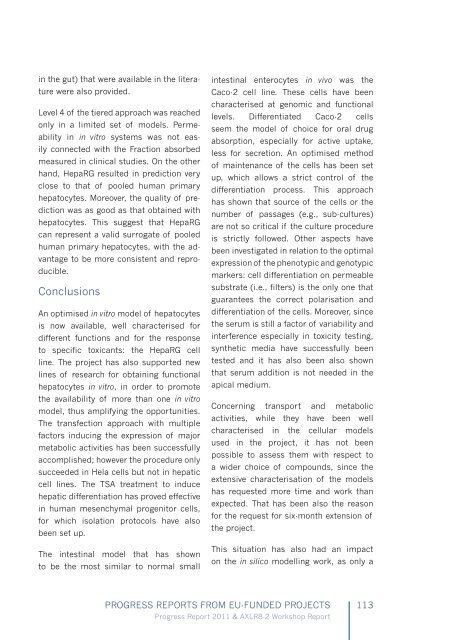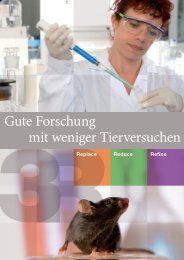You also want an ePaper? Increase the reach of your titles
YUMPU automatically turns print PDFs into web optimized ePapers that Google loves.
in the gut) that were available in the literature<br />
were also provided.<br />
Level 4 of the tiered approach was reached<br />
only in a limited set of models. Permeability<br />
in in vitro systems was not easily<br />
connected with the Fraction absorbed<br />
measured in clinical studies. On the other<br />
hand, HepaRG resulted in prediction very<br />
close to that of pooled human primary<br />
hepatocytes. Moreover, the quality of prediction<br />
was as good as that obtained with<br />
hepatocytes. This suggest that HepaRG<br />
can represent a valid surrogate of pooled<br />
human primary hepatocytes, with the advantage<br />
to be more consistent and reproducible.<br />
Conclusions<br />
An optimised in vitro model of hepatocytes<br />
is now available, well characterised for<br />
different functions and for the response<br />
to specific toxicants: the HepaRG cell<br />
line. The project has also supported new<br />
lines of research for obtaining functional<br />
hepatocytes in vitro, in order to promote<br />
the availability of more than one in vitro<br />
model, thus amplifying the opportunities.<br />
The transfection approach with multiple<br />
factors inducing the expression of major<br />
metabolic activities has been successfully<br />
accomplished; however the procedure only<br />
succeeded in Hela cells but not in hepatic<br />
cell lines. The TSA treatment to induce<br />
hepatic differentiation has proved effective<br />
in human mesenchymal progenitor cells,<br />
for which isolation protocols have also<br />
been set up.<br />
The intestinal model that has shown<br />
to be the most similar to normal small<br />
intestinal enterocytes in vivo was the<br />
Caco-2 cell line. These cells have been<br />
characterised at genomic and functional<br />
levels. Differentiated Caco-2 cells<br />
seem the model of choice for oral drug<br />
absorption, especially for active uptake,<br />
less for secretion. An optimised method<br />
of maintenance of the cells has been set<br />
up, which allows a strict control of the<br />
differentiation process. This approach<br />
has shown that source of the cells or the<br />
number of passages (e.g., sub-cultures)<br />
are not so critical if the culture procedure<br />
is strictly followed. Other aspects have<br />
been investigated in relation to the optimal<br />
expression of the phenotypic and genotypic<br />
markers: cell differentiation on permeable<br />
substrate (i.e., filters) is the only one that<br />
guarantees the correct polarisation and<br />
differentiation of the cells. Moreover, since<br />
the serum is still a factor of variability and<br />
interference especially in toxicity testing,<br />
synthetic media have successfully been<br />
tested and it has also been also shown<br />
that serum addition is not needed in the<br />
apical medium.<br />
Concerning transport and metabolic<br />
activities, while they have been well<br />
characterised in the cellular models<br />
used in the project, it has not been<br />
possible to assess them with respect to<br />
a wider choice of compounds, since the<br />
extensive characterisation of the models<br />
has requested more time and work than<br />
expected. That has been also the reason<br />
for the request for six-month extension of<br />
the project.<br />
This situation has also had an impact<br />
on the in silico modelling work, as only a<br />
PROGRESS REPORTS FROM EU-FUNDED PROJECTS<br />
Progress Report 2011 & AXLR8-2 Workshop Report<br />
113




